The cloud kitchen (aka ghost or virtual restaurant) model has revolutionized the food industry. These delivery-only kitchens forgo dine-in service and focus entirely on preparing meals for online ordering. Without the high overhead of front-of-house staffing and prime real estate, cloud kitchens can reach more customers at lower cost. Fueled by booming food delivery demand worldwide, this model offers flexibility and scalability – but it also comes with unique challenges. This guide walks aspiring entrepreneurs through every step of launching a cloud kitchen, from market research and business planning to licensing, operations, marketing, and profitability. We’ll compare cloud kitchens to traditional restaurants, highlight best practices (and pitfalls), and share real-world examples of successful virtual restaurants.
Figure: India’s cloud kitchen market is growing rapidly. In 2024 it was about US$1.13 billion and is projected to reach US$2.84 billion by 2030.
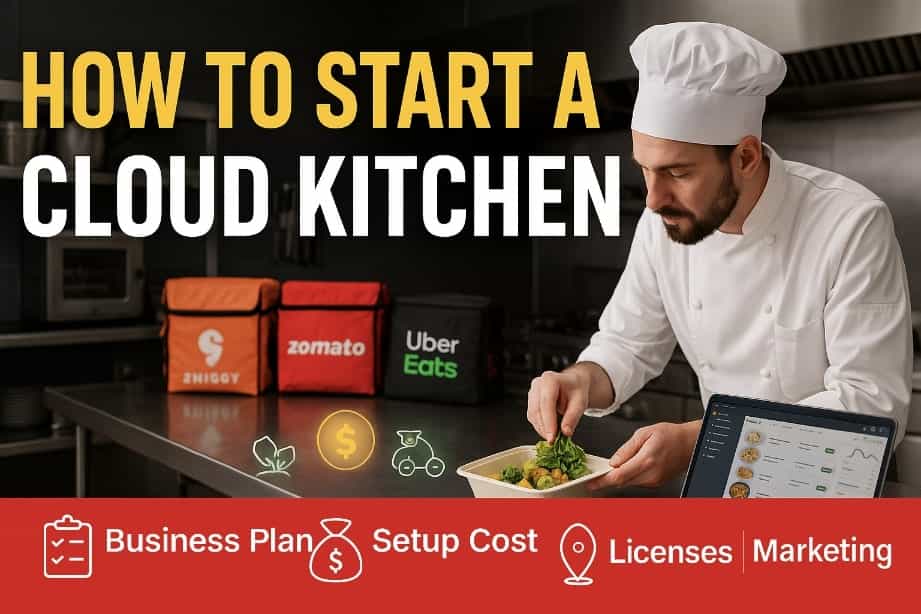
Market Research & Industry Trends
Before writing your cloud kitchen business plan, study the market. Cloud kitchens thrive on online ordering trends and customer preferences. In the US, UK, India and beyond, food delivery is surging (e.g. market research projects global cloud kitchen revenue to jump from ~$64 billion in 2023 to $144 billion by 2032). In India alone, cloud kitchens accounted for 12% of food delivery in 2024, and the market (₹9,747 crore) is forecast to grow at ~16.7% CAGR through 2030. Factors driving growth include smartphone penetration, rising incomes, and consumers’ appetite for variety. The pandemic accelerated adoption in Tier-2/3 cities and shifted habits toward ordering in.
- Target audience: Identify who will order your food. Are you serving busy professionals, college students, families, or late-night snackers? Pinpoint age groups, dietary trends (e.g. plant-based, keto, gourmet), and peak order times.
- Location analysis: A prime retail site is not needed – instead, look for kitchens with excellent delivery coverage. Map high-demand delivery zones using delivery app data or local demographics. Being near working offices or dense housing can boost volume. Also weigh rent vs. demand (cheaper spaces on building backstreets can suffice).
- Competitor research: List existing cloud kitchens and restaurants in your chosen area. Analyze their menus, prices, and customer reviews. Note what cuisines are popular and where the gaps are (e.g. few healthy options in one neighborhood). This informs your menu concept and pricing.
Use this research to define a strong cloud kitchen business plan. Outline your concept (cuisine and brand), initial investment estimates, pricing strategy, and growth goals. A good plan addresses operational flow (ingredient sourcing to delivery), staffing needs, marketing strategy, and financial projections (costs vs. expected sales). Consider consulting industry reports: for example, Fortune Business Insights notes rapid online delivery growth is the chief driver of cloud kitchen expansion.
Cloud Kitchen Business Models
Cloud kitchens can be organized in several ways. The business model you choose affects your cost structure and operations:
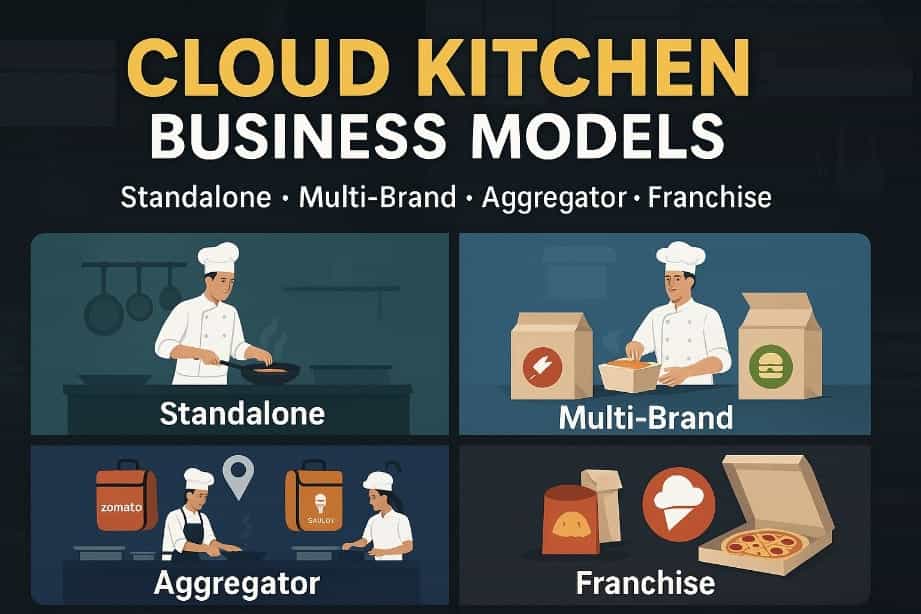
Figure: Common cloud kitchen business models (standalone brand-owned kitchens; shared multi-brand kitchens; third-party commissaries; co-working kitchens, etc.).
- Brand-Owned Single Kitchen: A single restaurant brand operates its own kitchen optimized for delivery only. This requires equipment and staffing for one concept. It gives full control (menu, branding) but you bear all costs. It’s like a normal restaurant without a dining room.
- Shared or Multi-Brand Kitchen: Several virtual brands share one kitchen space and staff. Chefs may rotate between brands, and ingredients are pooled. This shares costs (rent, utilities, staff) among partners. It also maximizes kitchen utilization (e.g. a breakfast brand busy in the morning and pizza in the evening can use the same resources at different times). Many food tech companies (Rebel Foods, Kitopi) use this model to scale many brands from fewer kitchens. Multi-brand kitchens often generate revenue by charging rent or commissions to hosted brands.
- Franchise or Licensed Kitchen: You operate under another brand’s name and recipes (franchise). The franchisor may supply some equipment or tech. This lets you leverage an established name and support, but costs include franchise fees and less menu flexibility.
- Aggregator/Commissary Kitchen: Large third-party operators (like CloudKitchens or Kitchen United) provide fully-equipped, delivery-focused kitchen spaces. They rent you a kitchen stall or station and may offer tech platforms for order management. This “off-the-shelf” model minimizes your startup hassle, but expect rental fees or revenue share.
- Restaurant-Owned Ghost Kitchen: An existing restaurant repurposes part of its kitchen (or opens a secondary kitchen) as a delivery-only outlet. This allows brand expansion into delivery without building a full new restaurant.
Choose the model that fits your goals. If you have an established brand, opening a separate delivery kitchen can reach new areas. If funds are limited, a shared space lowers risk. Multi-brand models work well for entrepreneurs wanting to test concepts quickly. Whatever you choose, define the roles of partners (ordering platforms, delivery fleets, POS systems) in your ecosystem.
Cloud Kitchen Business Plan: Key Steps
Use an organized business plan to turn ideas into action. Common steps include:
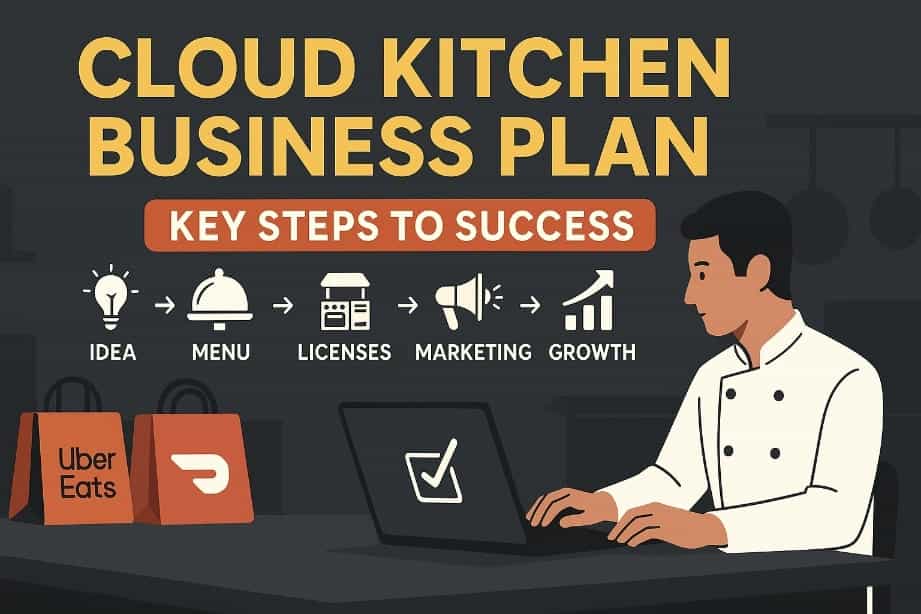
- Concept & Branding: Choose your cuisine or theme based on your market research. Pick a memorable brand name and logo – these will be what customers see on delivery apps. Create a strong online presence (website, social media) even before launch, so you can accept orders and build awareness.
- Menu Development: Design a focused menu tailored for delivery. Limit items to those that travel well and are cost-effective. Consider packaging needs (leaks, temperature). Use your research on food trends (e.g. plant-based, meal kits, ethnic cuisines) to differentiate your offerings.
- Financial Planning: Estimate startup costs (kitchen lease or buildout, equipment, licenses) and monthly expenses (ingredients, rent, utilities, labor, delivery fees). Calculate your break-even point: many new cloud kitchens take several months to turn a profit. Plan a buffer of working capital for the launch phase.
- Location & Lease: Secure your kitchen space. Unlike dine-in restaurants, you can locate in industrial or less prominent areas. Key factors are kitchen size/layout, access for delivery drivers, and proximity to your delivery zone. Keep lease terms flexible if possible (e.g. short-term or shared spaces) to pivot if needed.
- Equipment & Layout: Plan your kitchen layout for efficiency. You’ll need commercial cooking equipment (stoves, ovens, fryers, grills as per menu), stainless prep tables, storage shelving, refrigeration/freezer units, sinks and dishwashers, and adequate ventilation (exhaust hoods). Also invest in packaging stations (heat sealers, label printers). Exact equipment depends on cuisine; a small cloud kitchen in India notes full setup can cost ₹6–9 lakh (≈$7–11K).
- Licensing & Permits: Register your business and obtain all required food service permits (see section below). This often includes a business license, food hygiene permit, and (in many regions) a fire safety clearance. Work closely with local authorities for inspections and approvals early on.
- Staffing: Hire a core team of skilled kitchen staff – chefs/cooks, helpers, and packagers. Since there’s no dining area, focus on back-of-house roles. Train everyone in food safety, sanitation, and the specific workflows for quick order fulfillment. You may start with minimal staff and scale up as order volume grows.
- Technology Systems: Implement a cloud-based POS and order management system. A good POS will integrate multiple delivery platforms (UberEats, Swiggy, etc.) into one dashboard for easier processing. Also consider inventory software and analytics tools to track food costs and popular items.
- Partnerships: Sign up on major food delivery platforms. In the US/UK, important apps include DoorDash, Uber Eats (with Postmates), Grubhub (US), Deliveroo and Just Eat (UK). In India, partner with Swiggy and Zomato. Don’t rely on a single app – more listing means more visibility. Also explore local courier services for faster delivery and lower fees.
- Marketing Launch: Develop a launch campaign: teaser posts on social media, launch discounts or loyalty offers, and outreach to local food bloggers or influencers. Optimizing your menu listings with high-quality photos and keyword-rich descriptions (e.g. “spicy Korean tofu bowl” instead of just “tofu bowl”) helps your ranking in app searches. Plan to gather and showcase customer reviews (good reviews boost app visibility).
Break these steps into a timeline. For example, begin licensing 1–2 months before opening, and finalize equipment and hires 2–3 weeks out. Use checklists to track progress and ensure compliance.
Kitchen Setup & Equipment (Cloud Kitchen Setup Cost)
Equipping a cloud kitchen efficiently is critical. Since every square foot and rupee counts, focus on essentials and avoid unnecessary decor or furniture. Key equipment includes:
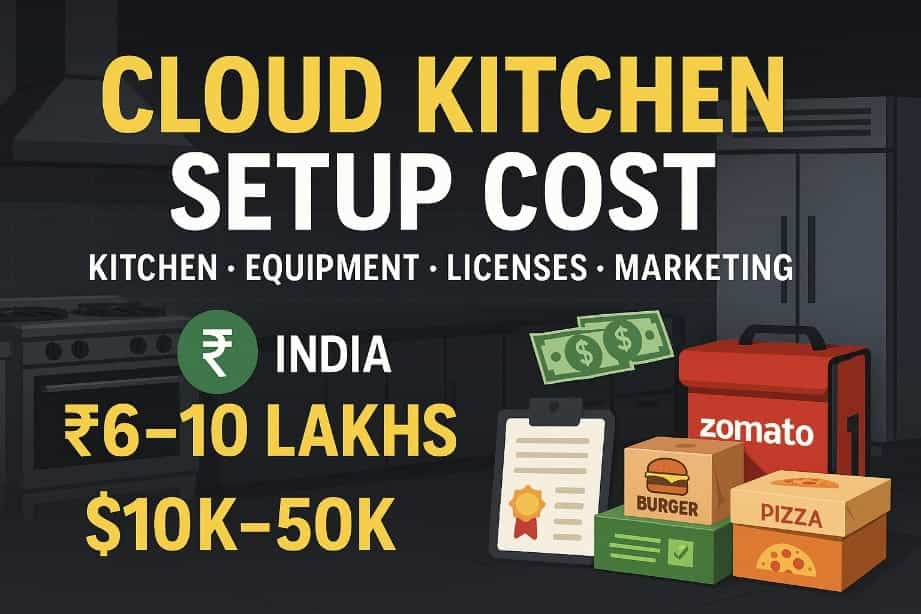
- Cooking Appliances: Commercial-grade stoves/ranges, ovens (pizza oven if needed), fryers, grills, steamers or specialized units depending on your menu. The initial cost of equipment varies: one Indian guide notes even basic burners and a prep table cost ₹60–70k (~$700-800). A fully-loaded kitchen might total several lakhs of rupees (₹6–9L).
- Refrigeration: Sufficient cold storage (reach-in fridges, freezers) to handle bulk supplies. Consider blast chillers if you’ll batch-cook. Proper refrigeration prevents spoilage and is a food safety requirement.
- Preparation & Storage: Stainless steel work tables, shelving racks, and utensil storage. Have dedicated sections for raw ingredients, spices, and packaging materials. Use color-coded cutting boards/knives for allergen safety.
- Packaging & Smallwares: Heat sealers, cling film wrap, to-go containers (consider eco-friendly options), bags, and sturdy boxes. Also get portion control tools (scoops, measuring cups) to maintain consistency.
- POS & Tech Setup: Install tablets or monitors for receiving online orders. Set up printers and Wi-Fi routers. If sharing a kitchen with multiple brands, a large central screen or tablets for each brand can streamline orders.
- Safety & Utilities: Fire suppression systems and emergency exits are mandatory in most jurisdictions. Ensure your gas and electrical systems meet code. Stock safety gear: fire extinguishers, first-aid kits, and non-slip mats.
Being cash-efficient matters. Buying some used equipment in good condition can cut costs. Also budget for maintenance tools (knife sharpeners, oil filters, cleaning supplies). The cloud kitchen setup cost can range widely: in India, equipment and licenses (FSSAI, trade, etc.) may sum to a few lakhs₹. In Western markets, entrepreneurs report initial budgets from ~$10K for a bare-bones shared kitchen up to $50K+ for a fully equipped standalone kitchen.
Technology Platforms & Operations
Modern cloud kitchens are tech-driven. Automate as much as possible to reduce errors:
- Point of Sale (POS): Choose a POS built for multi-platform orders. This system collects orders from apps (Uber Eats, Swiggy, etc.), processes payments, and updates inventory. A centralized dashboard prevents missed orders and overbooking. For example, some kitchens use systems that manage orders from all channels on one screen.
- Inventory Management: Cloud kitchens should track usage by the dish. Use a digital inventory tool to avoid running out of key ingredients. Automatic reordering can save time. This also links to cost control and profitability (know which items are costly or wasteful).
- Kitchen Display System (KDS): Instead of paper tickets, many kitchens use large screens showing real-time incoming orders. This speeds up communication between order taker and chefs, and ensures nothing slips.
- Data Analytics: Leverage data wherever possible. Track which dishes sell best, peak order times, and customer feedback. Tools that forecast demand (using AI) can optimize staffing and prep levels. Some advanced setups even use tablets in kitchens to pull up recipes or check allergens.
- Delivery Coordination: While third-party platforms handle actual delivery, integrate where possible with riders. Provide clear packaging and labels (with addresses and contents) to minimize mistakes. If you manage your own small delivery fleet, route-planning software can improve efficiency and customer satisfaction.
Overall, aim for seamless tech integration: from the moment a customer clicks “order” to when the meal arrives. Automation (like consolidating orders or forecasting) can reduce labor costs and errors, boosting margins.
Legal, Licensing & Food Safety
Running a cloud kitchen means complying with all the same regulations as any food business. The exact requirements vary by country and city:
- United States: Typically you need to register your business, obtain an EIN (tax ID), and get local business licenses. Most cities require a Certificate of Occupancy (verifying the space is approved for commercial kitchen use) and a Food Service Permit from the health department. If you sell alcohol, a liquor license is separate. Also ensure you follow OSHA safety codes. It’s wise to check state-specific rules or consult a restaurant attorney.
- United Kingdom: Register with the local council’s Environmental Health department (often at least 4 weeks before opening). If you have no dine-in, you still need approval as a food premises. Key rules are under the UK Food Hygiene Regulations – you must have a food hygiene rating, and staff must receive hygiene training. You’ll also need standard business registration (like a Company House registration) and adhere to FSA guidelines.
- India: Obtain an FSSAI license (Food Safety & Standards Authority of India) – mandatory for all food businesses; cost is relatively low (around ₹10k/year for basic registration). Register for GST (tax) since you’re supplying food. Get a trade license from local municipal authority, and register under the state’s Shops & Establishment Act even if you have no dining area. Also get a fire NOC/certificate and a construction permit if you built out the kitchen. In total, basic licensing costs around ₹40,000 in India.
- Other Countries: Research local food business regulations. In general, you will need: a business registration, a food hygiene/health permit, and a fire safety certificate. Some cities require regular inspections. In all cases, you must follow local food safety standards (temperature controls, sanitation, storage). For example, FDA’s FSMA rules in the US require hazard analyses for large operations, while the UK requires HACCP documentation.
Finally, carry adequate insurance: general liability (in case of accidents/injuries), property insurance, and worker’s compensation if you have employees. Insurance costs can be on the order of ~$1-5K per year depending on coverage.
Maintaining high food safety is non-negotiable. Implement strict hygiene protocols in the kitchen. Train staff in proper cooking temperatures, cross-contamination prevention, and sanitation. Display health certifications and ratings visibly to inspire customer trust. Remember, since you can’t interact face-to-face, online reviews about cleanliness or safety carry extra weight.
Delivery Partners and Ordering Platforms
A cloud kitchen’s lifeline is the delivery ecosystem. Partner with the leading delivery apps and consider multiple channels:
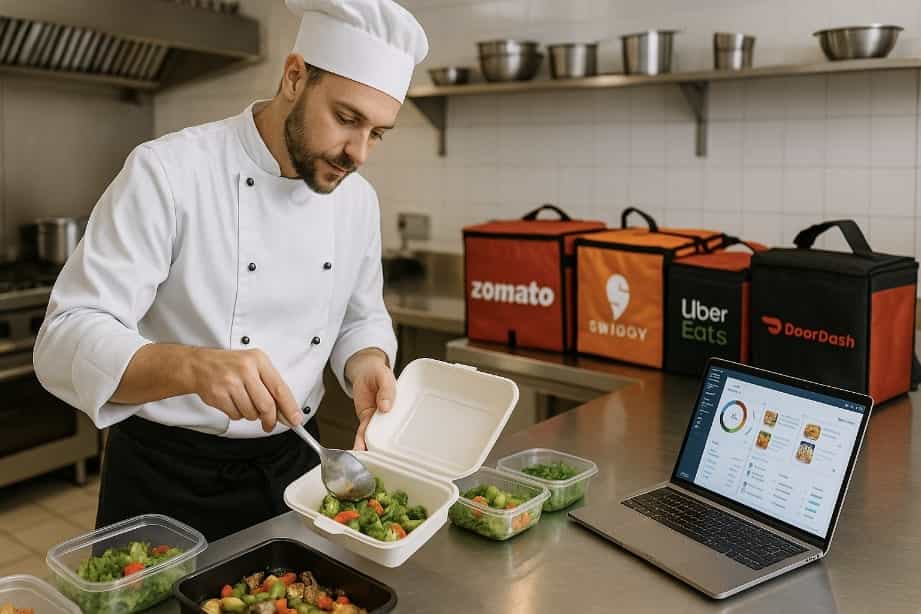
- Major Apps (US/UK): DoorDash, Uber Eats (with Postmates), and Grubhub dominate the US. In the UK and Europe, Just Eat and Deliveroo are top players. Listing on all relevant platforms maximizes exposure – 70-90% of cloud kitchen orders often come from these aggregators.
- Major Apps (India): Swiggy and Zomato cover most of the market. If budget allows, also list on smaller or niche apps (e.g. Dunzo, Uber Eats India).
- Other Options: Building your own Direct-to-Consumer (D2C) channel (website/app) is valuable long-term. It cuts out commission fees and gives you direct customer data. For example, promote a branded app by offering exclusive menu items or loyalty points. Many cloud kitchens also accept orders via WhatsApp or social media to drive direct business.
- Local Delivery Services: In some cities, partnering with local courier companies can ensure faster deliveries in crowded areas and lower fees. Offering real-time tracking or SMS updates via these services can delight customers.
To maximize orders on apps, optimize your listings: use clear, attractive photos and SEO-friendly dish names. Encourage happy customers to rate your menu highly – apps reward high ratings with better placement.
Monitor commissions carefully. On average, third-party apps charge 15-30% per order. Incentivize larger orders (bundles, combo meals) to offset fees, and push repeat customers to your own channels with loyalty rewards.
Cloud Kitchen Marketing & Branding Strategy
Even without a storefront, you still need a strong brand and marketing plan to attract customers. Focus on digital marketing and creative local outreach:
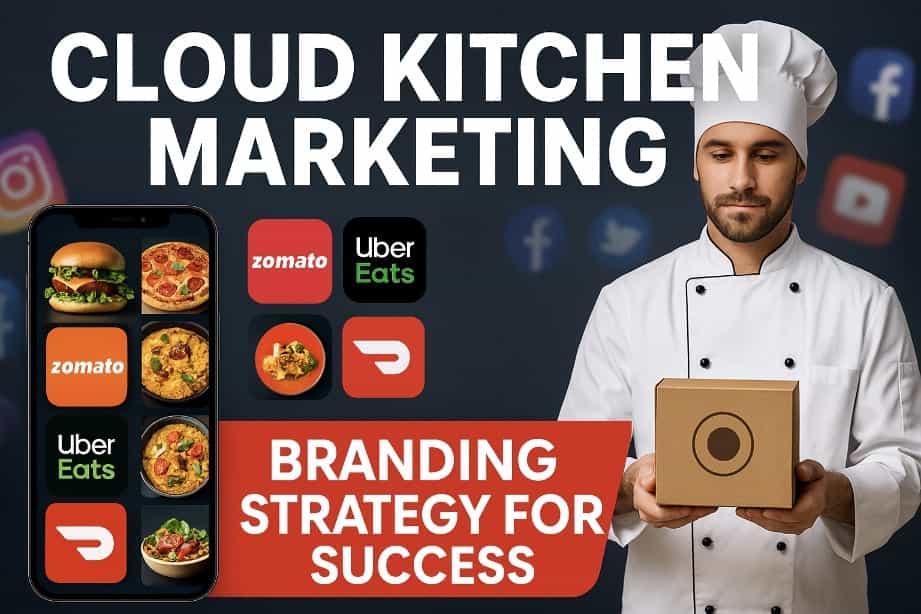
- Brand Identity: Develop a distinct brand story and logo that resonates online. Since customers judge you by your delivery app page, make it stand out (unique logos, uniform plating style). Consistency in branding (colors, fonts, tone) across social media and packaging builds trust.
- Online Listings SEO: On delivery apps, treat each menu item like a keyworded search listing. Use appetizing descriptions (e.g. “buttery garlic naan” vs. generic “naan”), and update seasonal specials. CloudKitchens research finds 70-90% of orders come via apps, so optimizing these listings is crucial.
- Social Media & Content: Use Instagram, Facebook, and Google My Business to share mouth-watering photos, customer testimonials, and behind-the-scenes videos. Offer occasional discounts or special promo codes to your followers. Collaborations with local food bloggers or micro-influencers can quickly increase awareness.
- Loyalty Programs: Encourage repeat business by rewarding customers. Digital loyalty points, referral bonuses, or “order 9 get 1 free” schemes can boost retention. Promote loyalty deals on receipts and confirmation emails. Personalize offers (birthday discounts, first-time order coupons).
- Local Online Ads: Use targeted Facebook/Instagram ads or Google Ads to reach people in your delivery zone. Highlight your top dishes and any opening offers. Geo-targeting ensures you’re not wasting budget on customers outside your range.
- Reviews & PR: Prompt happy customers to leave positive reviews on apps and social media. Feature glowing testimonials on your own site. In cities, consider PR stunts (e.g. charity meal donation drives, sponsoring a local event) to earn free press.
Overall, think of ghost kitchen marketing as digital-first. You won’t get foot traffic, so all “brand-building” happens online. Track metrics (click-throughs, conversion rates on ads) and tweak your approach. A/B test promo offers or social media content to see what resonates.
How to pitch your brand and tell your story
Hiring and Staffing
Cloud kitchens typically run lean staffing compared to full-service restaurants:
- Kitchen Team: You’ll need skilled cooks/chefs who can work quickly on a tight menu, plus assistants or line cooks for prep and plating. Cross-train staff so they can shift roles as needed (e.g. one cook handling multiple cuisines if you have multi-brand operations).
- Packing Crew: Assign team members or hire workers specifically for packing and quality-checking orders. They must pack with care (no spills) and double-check accuracy before sealing orders.
- Management & Support: Even with no front-of-house, you’ll need a manager or owner oversight to handle inventory, monitor orders, and liaise with platforms. In small setups, the owner often performs these roles initially.
- Training: Every staff member, from cook to packer, should be trained on food safety protocols and efficient procedures. Reinforce hygiene (hand washing, gloves), allergen awareness, and speed/accuracy under pressure. Documented training is often required for health compliance.
- Culture: Foster a teamwork mentality. Since orders are continuous, clear communication and a positive attitude are vital. Even though customers don’t see your kitchen, their experience depends on your team’s performance. Reward good service and efficiency (e.g. on-time bonus, free meals) to motivate staff.
Stocktake (a restaurant management platform) emphasizes “hire pro chefs and kitchen workers who know making and packing for delivery” and strongly train them on food safety and customer service standards. This focus on professionalism and hygiene will pay off in reliability and customer trust.
Customer Acquisition & Retention
Acquiring and keeping customers is key to profitability:
- First Orders: Offer first-time discounts or free delivery to entice new customers to try your kitchen. Package inserts (e.g. a coupon for next order) can encourage reorder. Partnering with delivery apps on new restaurant promotions can also boost initial visibility.
- Customer Data: For any orders via your own site or phone, collect emails/phone numbers for marketing. Send newsletters or SMS with special offers to past customers. Personalization (e.g. “We miss you! 10% off your favorite curry”) builds loyalty.
- Loyalty and Referral: As noted, loyalty programs increase repeat business. Run referral campaigns (e.g. “Give $5, Get $5” for friend referrals). Reward best customers publicly (e.g. “Top Customer of the Month”) on social channels.
- Customer Feedback: Actively request and monitor reviews on delivery platforms. Respond professionally to complaints (refunds, apologies) to show you care. Implement popular customer suggestions (spiciness level, packaging notes) to improve service. This not only saves churn, it can convert unhappy customers into promoters.
- Partnerships: Team up with corporate offices or event planners for catering deals. Offices ordering lunch boxes or meetings require delivery-only solutions, which your kitchen can provide. Corporate accounts give steady volume (often 10+ meals at once).
- Incentivize Large Orders: Offer tiered pricing or combo deals to encourage customers to order more. Since delivery apps charge per order, higher-value orders often mean better margins.
Continuously analyze your customer acquisition cost vs. lifetime value. Refine your marketing spend: ads and promotions should ideally pay for themselves in repeat business. A well-run cloud kitchen can break even in a few months and then steadily grow profits, especially if you convert many one-time customers into regulars.
Profitability and Financial Management
Running a profitable cloud kitchen requires careful cost control and smart pricing:
- Cost of Goods Sold (COGS): Aim for a food cost around 25-35% of menu price (varies by cuisine). Track ingredient costs daily. Standardize recipes to prevent waste. Bulk purchasing and sharing ingredients across brands (in a multi-brand kitchen) can lower costs.
- Operational Efficiency: High-volume throughput is your friend. Since overhead is lower (no dining service), profits come by selling many meals. Automate prep tasks if possible. For example, pre-portion sauces or use smart burners that reduce gas usage. Monitor labor hours vs. orders and adjust staffing to avoid idle time.
- Delivery Fees & Commission: As mentioned, app commissions can be 20-30%. Build these fees into pricing or minimize their impact. Encouraging direct orders (via your website/app) can save these costs.
- Break-Even Analysis: Calculate how many orders per day you need to cover fixed costs (rent, salaries, internet). Keep in mind seasonal dips (plan for slower months). Many entrepreneurs set aside 3-6 months of operating expenses as a buffer.
- Revenue Diversification: Consider multiple revenue streams. For example, offer meal kits, grocery items, or subscription meal plans. These can stabilize income and increase customer value. Some cloud kitchens partner with meal delivery subscription services for steady orders.
- Financial Tracking: Use your POS’s reporting to monitor sales, COGS, and profits by menu item. Trim underperforming dishes and double down on best-sellers. Regularly audit expenses (utility bills, app commission rates) to find savings.
With low rent and staff costs, gross margins for cloud kitchens can be quite high (often 50-70% before delivery fees). Net profits depend on achieving sufficient volume and managing marketing spend. By optimizing operations (e.g. using data analytics to forecast demand) and increasing direct orders, some cloud kitchens report profit margins on par with traditional restaurants or higher.
Funding options and investment planning
Cloud Kitchen vs. Traditional Restaurant: Pros and Cons
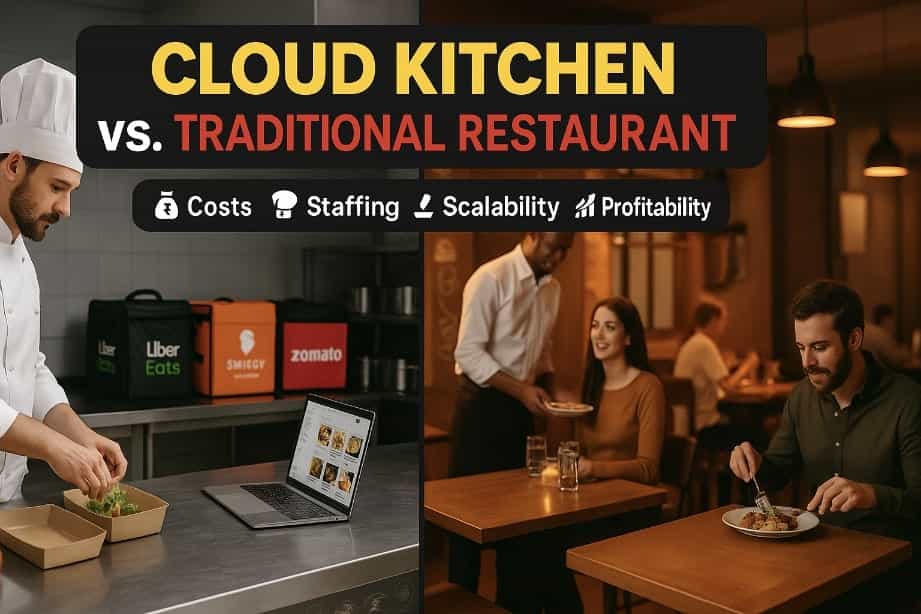
| Aspect | Cloud Kitchen | Traditional Restaurant |
|---|---|---|
| Location | Low-cost, delivery-focused area; parking/delivery access. | Prime retail area; needs foot traffic. |
| Startup Cost | Lower (no dining area, furniture, or prime lease). | Higher (interior, seating, decor, large space). |
| Staffing | Minimal front-of-house; focus on cooks/packers. | More staff needed (waiters, hosts, etc.). |
| Overhead | Lower rent/staff; often single-shift operations. | Higher rent, utilities for dining area; sometimes 24/7 staff. |
| Menu Flexibility | Easy to tweak menu or add brands based on demand data. | Harder to test new items due to menu reprints/customer expectation. |
| Marketing | Digital-focused (apps, social media). | Mix of digital and local promotion; relies on walk-ins. |
| Scalability | Can replicate quickly in new locations; multi-brand easier. | Expanding requires new site and heavy investment. |
| Customer Experience | No dine-in ambience; relies on packaging quality and delivery. | Provides ambience, service, direct customer interaction. |
| Profit Drivers | Volume of online orders; lower fixed costs. | Table turnover and in-restaurant sales; potentially higher per-order spend (drinks, dessert). |
| Vulnerability | Dependent on delivery platforms (and their fees). | Vulnerable to location competition and dine-in trends. |
Pros of Cloud Kitchens: Lower fixed costs, flexibility to experiment with menus/brands, and ability to focus on delivery efficiency. They can pivot faster (e.g. adding a new cuisine concept overnight) and scale by adding kitchen locations without major build-outs.
Cons: High dependency on delivery platforms (and their commission cuts). Lack of direct customer contact means all branding happens online. No walk-in revenue or beverage sales. Intense competition on apps can lead to price wars. Ensuring consistent demand (so the kitchen isn’t idle) is challenging.
In short, cloud kitchens are not a guaranteed money-spinner, but they offer an alternative route for restaurateurs in the digital age. They are often easier to start than a full restaurant, but require excellent digital marketing and operational discipline to succeed.
Case Studies: Success Stories
Rebel Foods (India) – Co-founded by ex-McKinsey entrepreneurs, Rebel Foods (formerly Faasos) is one of the largest cloud kitchen networks globally. It operates 450+ kitchens across 70+ cities and runs 45+ brands (from wraps and pizza to biryani and Pan-Asian). Rebel Foods’ founders pivoted from dine-in restaurants to a multi-brand cloud kitchen model in 2015, which slashed real estate costs and allowed rapid menu innovation. Their tech platform manages inventory, demand forecasting and deliveries across all brands. Rebel’s approach highlights key best practices: digital branding for each sub-brand, data-driven menu tweaks, and cross-brand synergies in a single kitchen.
CloudKitchens (USA) – Founded by Uber’s Travis Kalanick, CloudKitchens provides kitchen spaces to virtual restaurant operators. They monetize by renting kitchen stalls and providing integrated order-management software. This model exemplifies the aggregator/commissary approach, taking advantage of shared real estate to serve multiple virtual brands.
Kitopi (UAE) – Dubai-based Kitopi is a food-tech unicorn running dozens of cloud kitchens across the Middle East and expanding to Western markets. They focus on partnering with existing restaurant brands to handle their delivery operations, leveraging tech and a multi-brand model. Their rapid growth (raising hundreds of millions in funding) shows the global appetite for outsourced cloud kitchen infrastructure.
These examples show how blending technology, data, and delivery can redefine restaurant profitability. You may not become a unicorn overnight, but you can learn: build a strong tech stack, diversify your menu (multiple virtual brands can share resources), and always listen to customer data.
Ghost Kitchen Marketing Strategy: Key Takeaways
- Optimize delivery app presence: Use appetizing, keyword-rich menu titles and photos. Keep menus fresh (rotate specials) to appear active.
- Drive direct orders: Build a website/app or use order links to capture customer info and avoid app fees. Run exclusive deals for direct channels.
- Leverage loyalty: Digital loyalty programs (points, free meals) greatly boost repeat business.
- Data-driven menus: Use analytics to focus on high-margin, popular dishes and trim underperformers.
- Community engagement: Partner with local influencers or participate in food events. Unique promotions or collaborations (e.g. pop-up kitchens) can create buzz.
- Respond to feedback: Monitor reviews on platforms and adapt quickly. A highly-rated ghost kitchen will appear higher in app search results.
By combining these strategies, a cloud kitchen can build a loyal customer base even without a physical storefront.
Conclusion: Is a Cloud Kitchen Right for You?
Starting a cloud kitchen can be an exciting way to enter the food business with relatively lower risk. The advantages – lower upfront investment, flexibility, and growth potential – make it appealing. But success requires meticulous planning: solid market research, a clear business plan, and excellence in execution (food quality, hygiene, and timely delivery).
If you’re an entrepreneur who’s tech-savvy and marketing-focused, and you crave running a restaurant without the traditional overhead, a cloud kitchen could be ideal. You’ll need to embrace data-driven decision-making, digital branding, and continuous menu innovation. Keep a close eye on finances (to stay profitable) and treat your delivery drivers and customers as your direct “clients” – their satisfaction is your reputation.
In the words of IBEF’s 2025 report, cloud kitchens are “a smart and flexible option for today’s food industry”. Whether you’re in New York, London, or Mumbai, the playbook is similar: solve a food need with a great menu, streamline your operations, partner effectively with delivery platforms, and market your brand online. Follow the guidelines above – and you’ll be well on your way to launching a successful cloud kitchen.
FAQs on Starting a Cloud Kitchen
- What is a Cloud Kitchen and how does it work?
A cloud kitchen, also called a ghost kitchen or virtual restaurant, is a delivery-only food business that operates without a dine-in facility. Customers place orders online through food delivery apps like Swiggy, Zomato, Uber Eats, or DoorDash, and the food is prepared in a professional kitchen designed solely for delivery.
- How much does it cost to start a Cloud Kitchen?
The cloud kitchen setup cost depends on the location, equipment, and business model. In India, a basic setup can cost between ₹6–10 lakhs, while in the US or UK, it can range from $10,000 to $50,000. Costs include kitchen equipment, licenses, rent, branding, packaging, and initial marketing.
- What licenses are required for a Cloud Kitchen?
Licensing depends on the country:
India: FSSAI license, GST registration, Trade license, Fire NOC, Shops & Establishment registration.
US: Food Service Permit, Business License, Certificate of Occupancy, EIN, and insurance.
UK: Food business registration with the local council, Food Hygiene certification, HACCP compliance.
Always check with local authorities to ensure compliance with food safety standards. - How do I create a Cloud Kitchen business plan?
A cloud kitchen business plan should include:
Market research and target audience.
Menu design and pricing strategy.
Setup costs, operating expenses, and revenue projections.
Equipment and staffing requirements.
Marketing and branding strategies.
Partnerships with delivery platforms. - Which are the best delivery apps for Cloud Kitchens?
The best apps depend on location:
India: Swiggy, Zomato.
US: Uber Eats, DoorDash, Grubhub.
UK: Deliveroo, Just Eat, Uber Eats.
Most successful cloud kitchens list on multiple platforms to maximize visibility. - Is a Cloud Kitchen profitable?
Yes, cloud kitchens can be highly profitable due to lower rent, staffing, and maintenance costs compared to traditional restaurants. However, profitability depends on consistent order volume, efficient operations, customer retention, and reducing dependency on third-party apps by building direct customer channels.
- What is the difference between a Cloud Kitchen and a Traditional Restaurant?
A cloud kitchen operates online only with no dine-in area, focusing on delivery orders, while a traditional restaurant relies on dine-in customers, ambience, and table service. Cloud kitchens save costs on interiors and front-end staff, whereas traditional restaurants earn extra revenue through dine-in upselling (beverages, desserts).
- How can I market my Cloud Kitchen effectively?
Effective cloud kitchen marketing strategies include:
High-quality food photos and SEO-optimized menu listings on delivery apps.
Social media promotions and collaborations with food influencers.
Loyalty programs and referral discounts.
Google Ads and geo-targeted social media ads.
Building a direct ordering website/app to reduce commission fees. - What are the common challenges in running a Cloud Kitchen?
Some challenges include:
High dependency on delivery platforms and their commission fees.
Maintaining food quality and hygiene during packaging and delivery.
Building a strong brand without direct customer interaction.
Managing logistics during peak hours.
Standing out in highly competitive online marketplaces. - Can I run multiple brands from one Cloud Kitchen?
Yes. Many entrepreneurs operate multi-brand cloud kitchens from a single space. For example, one kitchen might serve pizza under one brand and healthy salads under another. This increases revenue potential while sharing the same infrastructure and staff.